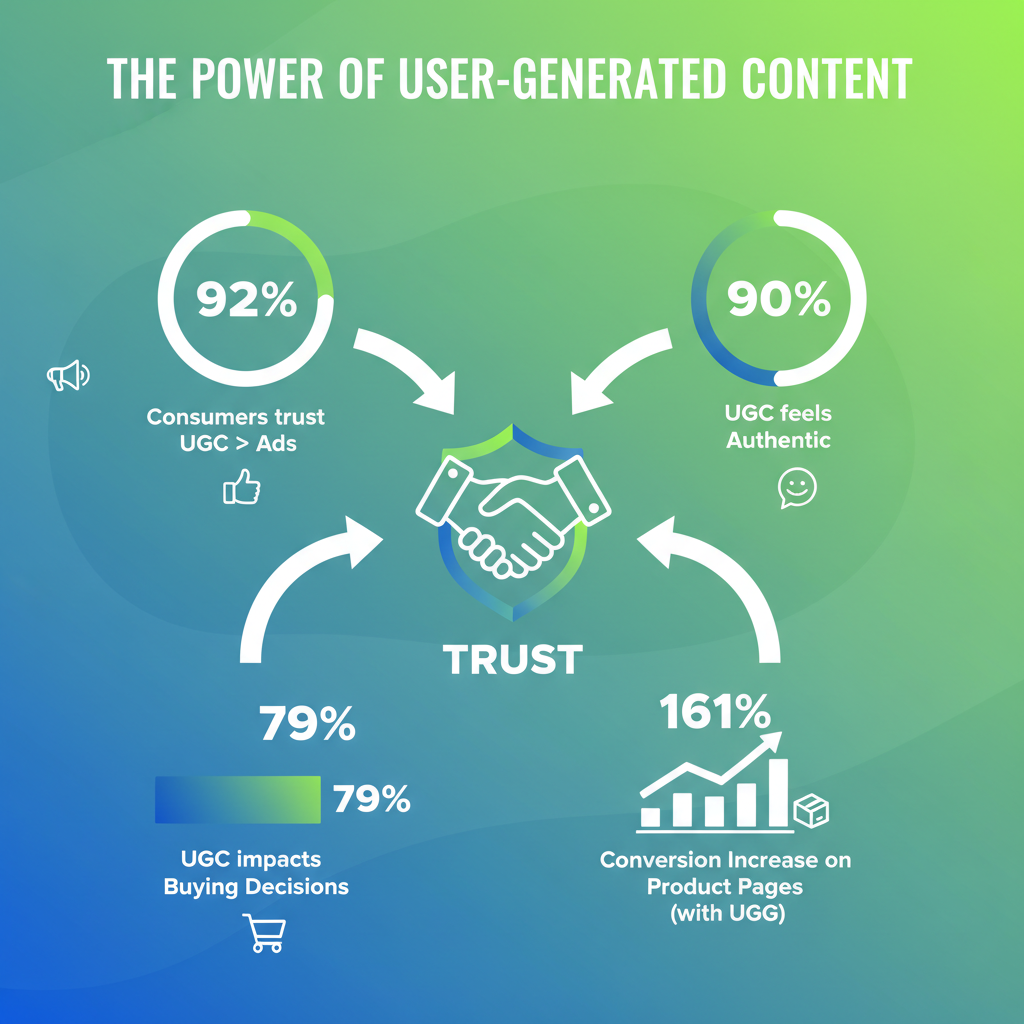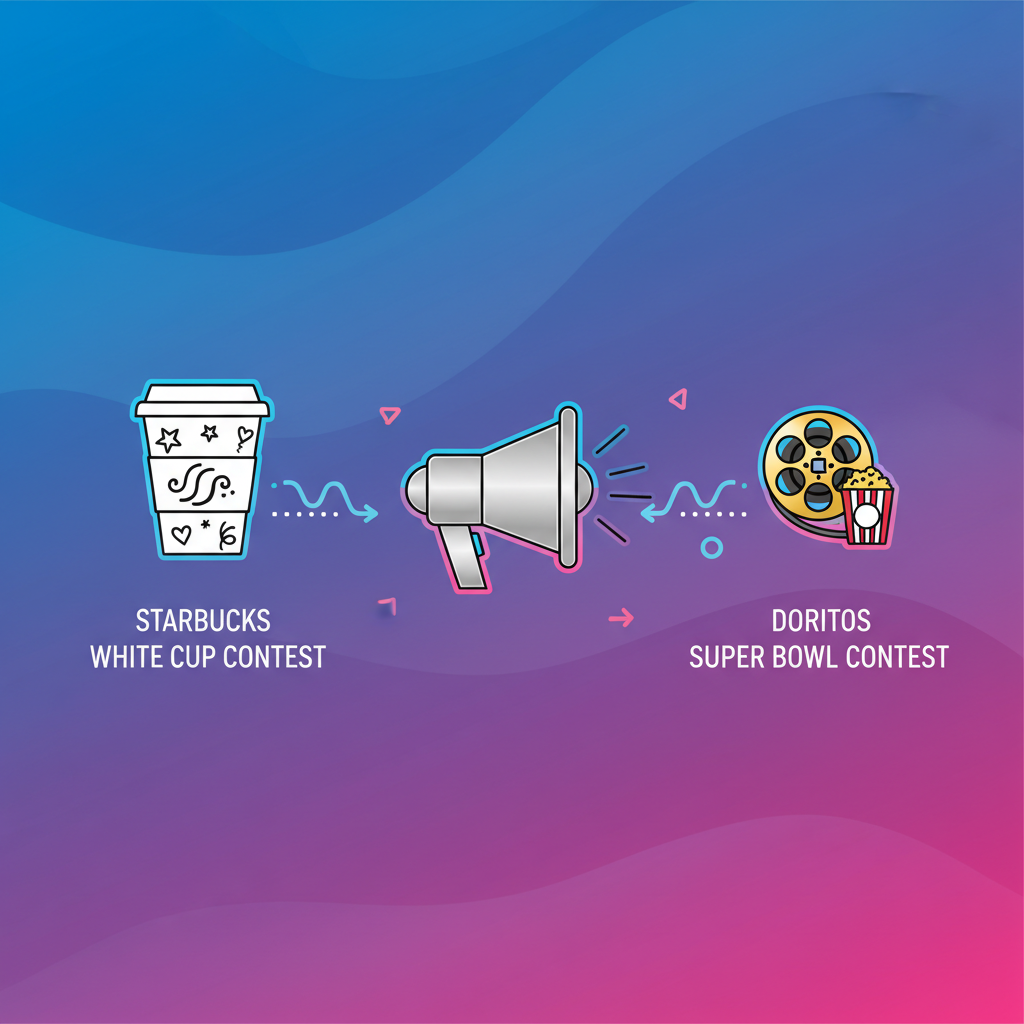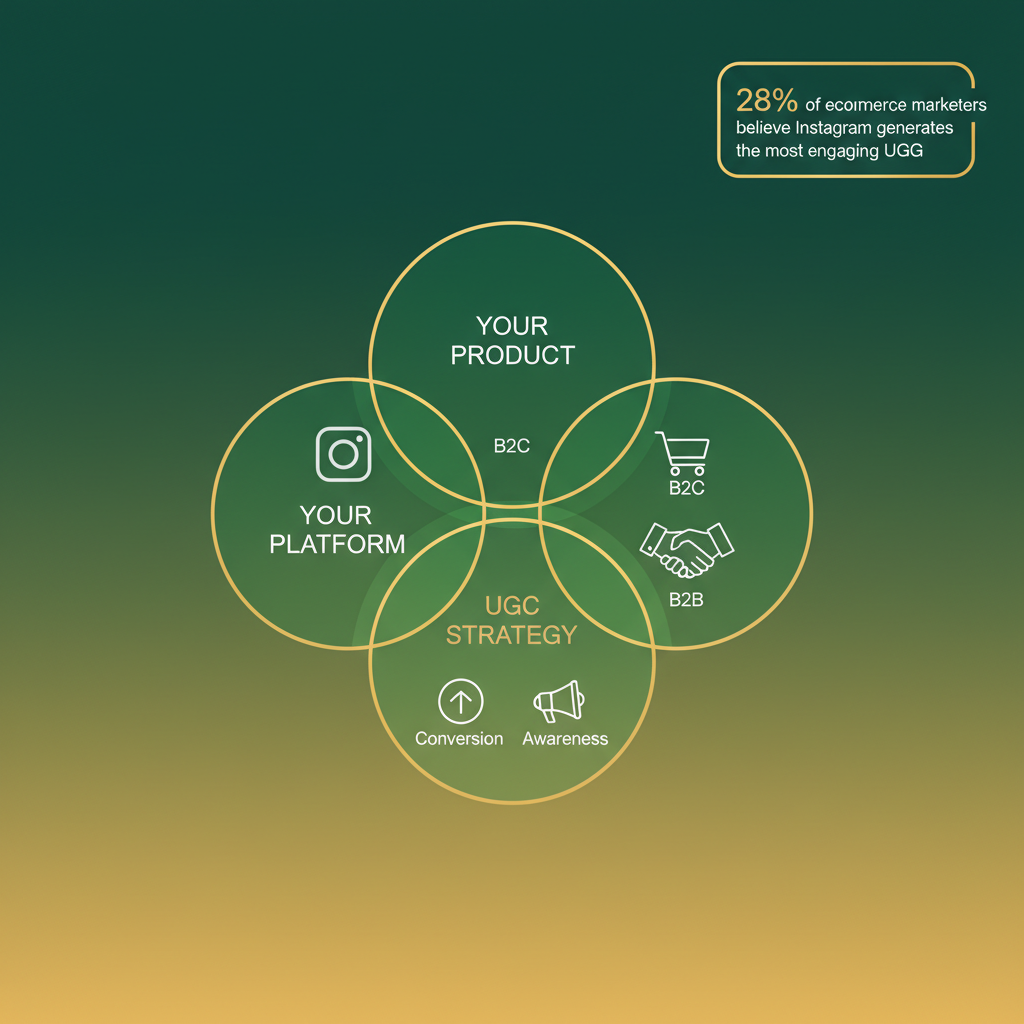Key Takeaways
- User-Generated Content (UGC) is crucial for building trust and authenticity, as consumers trust peers more than traditional advertising.
- The seven key types of UGC are: Images, Videos, Customer Reviews & Testimonials, Social Media Mentions, Blog Posts, Contest Submissions, and Community Discussions.
- The right type of UGC for your brand depends on your target platform, the nature of your product (B2C vs. B2B), and your specific marketing goals (e.g., conversions, engagement).
- Visual content like images and videos are highly effective on platforms like Instagram, while written testimonials and case studies excel for B2B marketing.
- Actively encouraging UGC through contests and community building can generate a large volume of authentic content and increase brand loyalty.
Table of Contents
- What is User-Generated Content (and Why Does it Work so Well?)
- The 7 Main Types of UGC Content Your Brand Can Leverage
- How to Choose the Right Types of UGC Content for Your Brand
- Conclusion
- Frequently Asked Questions
In a world full of polished ads and perfect marketing messages, being real is the most valuable thing a brand can be. The best way to show you are real is to let your happy customers do the talking for you.
To use this amazing power, brands first need to learn about the different types of ugc content they can use. Knowing this is the first step to building a strong marketing plan that is driven by your community of fans.
You are here because you want to learn about the different kinds of user-generated content. This guide will help you figure out which types of ugc content are the perfect choice for your brand’s goals, what you sell, and who you are trying to reach.
This post will break down the seven most important types of user-generated content. We will give you clear explanations and real-world ugc examples to help you get ideas for your next campaign.
What is User-Generated Content (and Why Does it Work so Well?)

User-Generated Content, or UGC, is any kind of content that is made by regular people instead of the brand itself. This can be text, videos, pictures, reviews, and more. Think of it as content made by customers or fans, not by a marketing team.
Essentially, user-generated content (UGC) is content produced by customers, not the brand, and it comes in many forms. Some of the most common user generated content examples you’ve probably seen are customer reviews on a website, social media posts from people using a product, and unboxing videos on YouTube.
Meet Fan Generated Content
Another great name for this is fan generated content. This term highlights the passion and loyalty of a brand’s biggest supporters. These are people who love a product so much that they create content about it for free, simply because they want to share their positive experience. This kind of content is incredibly powerful because it comes from a place of genuine excitement.
The Core Benefits: Building Trust and Driving Decisions
So, why is UGC so effective? It all comes down to trust and social proof. People trust other people more than they trust advertisements. When a friend, family member, or even a stranger online recommends something, it feels more honest and believable than a brand saying its own product is the best.
The numbers back this up. An incredible 92% of consumers trust word of mouth and UGC more than traditional advertising. This is because it feels real. In fact, 90% of consumers say they find UGC more authentic and trustworthy than content made by brands.
This trust has a direct impact on whether people decide to buy something. Research shows that 79% of consumers say UGC impacts their buying decisions. Putting this content where people can see it works wonders. For example, simply placing UGC on product pages can increase conversions by 161%. It gives shoppers the final bit of confidence they need to click “buy now.”
The Power of Authentic, Unpolished UGC Style Content
One of the biggest strengths of UGC is that it isn’t perfect. The raw, unpolished nature of ugc style content makes it feel real and relatable. A selfie with a new skincare product or a shaky video of a new gadget feels more genuine than a perfect, professionally shot advertisement.
Video is especially powerful in this area. A study found that UGC-style video is a uniquely powerful medium because it shows real human stories. This style is now the most popular type of content on social media. It’s no surprise that platforms such as TikTok, Instagram Reels, and YouTube Shorts prioritize UGC-style content, as it keeps users engaged and entertained.
The 7 Main Types of UGC Content Your Brand Can Leverage

User-generated content comes in many different shapes and sizes. Understanding each type will help you decide which one to focus on. Here are the seven most impactful types of UGC that your brand can start using today to build trust and connect with customers.
1. UGC Images
What it is: UGC images are photos taken by your customers that show your product or service being used in a real-life situation. This could be someone wearing your brand of jeans, using your face cream in their bathroom, or enjoying a vacation you helped book.
Why it’s valuable: These customer photos provide strong visual social proof. They help potential buyers imagine themselves using the product, which makes it seem more real and desirable. UGC images are perfect for sharing on social media platforms like Instagram, adding to your product pages to show real-world results, and even using in your digital ads. They add a layer of authenticity that studio-shot photos just can’t match.
UGC Examples:
- GoPro: The action camera brand GoPro built its entire marketing strategy on the amazing photos and videos its users capture. Instead of just talking about their camera’s features, GoPro showcases thrilling real-life action shots from users, from deep-sea diving to mountain climbing. This proves the product’s quality in the most exciting way possible.
- Apple: Another brilliant example is Apple’s “Shot On iPhone” campaign. Apple uses beautiful photos taken by regular iPhone users on giant billboards and in commercials. This campaign does two things perfectly: it shows off the amazing quality of the iPhone’s camera and celebrates the creativity of its customers.
2. UGC Videos

What it is: UGC videos are a very broad and super engaging type of content created by users. They can be anything from a short clip to a long, detailed review. This is one of the most popular and effective types of ugc content.
Here are the different sub-types of UGC videos:
- Unboxing Videos: This is where a customer films themselves opening a product for the very first time. These videos capture the pure, unfiltered excitement and first impressions of receiving a package.
- Tutorials/How-To’s: In these videos, users show others how to use a product. This could be a makeup tutorial using a certain eyeshadow palette, a recipe made with a specific kitchen gadget, or a guide on how to assemble a piece of furniture.
- Video Testimonials: This is when a happy customer talks on camera about their positive experience with a product or service. Hearing and seeing someone share their success story is often much more convincing than reading a written review.
- Short-Form Creative Videos: This includes TikToks, Instagram Reels, and YouTube Shorts. Users creatively feature a product in a popular dance, a funny skit, or a trending challenge. This is a fun and modern way to get your brand seen.
Why it’s valuable: Videos are amazing at grabbing people’s attention and stopping them from scrolling past on social media. They are dynamic and can explain how a product works much better than text alone. The content can range from heartfelt testimonials to creative product demonstrations, giving brands a wide variety of authentic material. When done right, successful UGC video review campaigns can revolutionize industries and inspire incredible creativity.
3. Customer Reviews and Testimonials

What it is: This is the original, classic form of UGC. Customer reviews are written comments left by customers on product pages, on third-party websites like Amazon, G2, or Yelp, or even sent directly to a company through email.
Why it’s valuable: Reviews are the foundation of trust online. For many shoppers, reading reviews is the very last step they take before deciding to make a purchase. They provide unbiased social proof and can answer specific questions or concerns that potential buyers might have. Positive reviews from past customers make new customers feel safe and confident in their choice.
It’s clear that people rely heavily on the opinions of others. Research shows that 84% of consumers trust peer reviews and recommendations more than they trust content created by the brand itself. This makes collecting and displaying customer reviews one of the most important things any online business can do.
4. Social Media Mentions & Comments
What it is: This type of UGC happens anytime your brand is mentioned, tagged, or talked about on social media. This can include a customer posting a photo and tagging your brand, leaving a positive comment on one of your posts, or tweeting about a great customer service experience they had.
Why it’s valuable: Social media mentions are raw, immediate, and feel extremely authentic. Unlike a formal review, a quick tweet or an Instagram story mention feels like a genuine shout-out. Brands can easily take screenshots of these positive comments and share them on their own social media stories, in email newsletters, or on their website to show off their happy customers. They are like mini-testimonials that you can collect every single day. In fact, social media posts are a well-known form of user-generated content that provides a constant stream of fresh, authentic marketing material.
5. Blog Posts & Case Studies
What it is: Sometimes, a customer is so impressed with a product or service that they write a whole blog post about it. This is in-depth, long-form content where a user details their entire experience. This is especially common in industries like business software (B2B), technology, and travel, where purchases are a bigger decision.
Why it’s valuable: These detailed articles provide deep social proof and can work as powerful case studies. They explain not just what the product does, but how it solved a real problem for the user. This is a perfect example of high-quality fan generated content that can influence people who are thinking about making a big purchase. Someone might spend hours researching a new software for their company, and finding a detailed blog post from a current user can be the thing that convinces them to choose your brand. These user-written blog posts serve as detailed testimonials that can sway even the most careful buyers.
6. Contest & Challenge Submissions

What it is: This is content that your brand actively asks for. You create a campaign, a contest, or a hashtag challenge, set the rules, and your audience creates content to join in and win a prize.
Why it’s valuable: This is a fantastic way to get a lot of specific ugc images or ugc videos in a short amount of time. It encourages your audience to get involved with your brand, boosts engagement on your social media, and creates a fun sense of community. Instead of waiting for customers to create content on their own, you are giving them a reason to do it right now.
UGC Examples:
- Starbucks: A famous example is the Starbucks “White Cup Contest.” Starbucks encouraged customers to draw creative doodles on their plain white cups, take a photo, and submit it. This simple idea generated thousands of unique, artistic images and created a huge amount of buzz online.
- Doritos: The snack brand Doritos is known for getting competitive with its UGC. For years, Doritos ran a “Crash the Super Bowl” contest where they asked fans to create their own Doritos commercials. The winning fan-made ad was then shown during the Super Bowl, one of the biggest advertising events of the year. This was a brilliant way to get high-quality video content and make fans feel like a part of the brand’s story.
7. Forum & Community Discussions
What it is: This is content that you can find in specific online communities, like Reddit, Quora, Facebook Groups, or even on a brand’s own dedicated forum. It includes customers asking questions about a product, sharing tips and tricks with each other, and having natural conversations about a brand.
Why it’s valuable: These platforms provide a completely unfiltered look into what your customers are really thinking. By reading these discussions, brands can learn how their products are actually being used, find out about common problems or questions, and find amazing, authentic quotes to use in their marketing. It’s like being able to listen in on a focus group, 24/7.
UGC Examples:
- Lego: One of the best examples of a brand with a strong online community is Lego. The LEGO Ideas platform is a special website where fans can design their own Lego sets, submit them, and have other fans vote on them. If an idea gets enough votes, Lego will consider turning it into a real product that they sell in stores. This is the ultimate form of community collaboration.
- SEMRush: The marketing software company SEMRush has built a great reputation by being helpful in online communities. A Reddit user pointed out that SEMRush is very active in the r/SEO subreddit, where they don’t just promote their product but actually answer questions and give valuable advice. This builds trust and makes them look like a helpful expert in their field.
How to Choose the Right Types of UGC Content for Your Brand

Now that you know the seven main types of UGC, you might be wondering: which one is right for my brand? The best choice depends on three key things: your platform, your product, and your goals. Let’s break it down.
Factor 1: Consider Your Platform (Where is your audience?)
Different social media platforms are designed for different kinds of content. You should focus on collecting the type of UGC that works best on the platforms where your audience spends the most time.
- For visual platforms like Instagram: If your audience loves Instagram, you should prioritize collecting high-quality UGC images and short, engaging UGC videos (like Reels). It’s no surprise that nearly one-third (28%) of ecommerce marketers believe Instagram generates the most engaging UGC. The platform is built for beautiful visuals, so customer photos and videos are king.
- For professional platforms like LinkedIn or a B2B Website: If you are selling to other businesses (B2B), your audience is likely on platforms like LinkedIn. Here, written testimonials, detailed reviews, and in-depth blog posts or case studies will be much more effective. Professional audiences want to see proof of results and expertise.
Factor 2: Consider Your Product (What are you selling?)
The type of product you sell plays a big role in what kind of UGC will be most effective. There’s a big difference between selling a fun product to a consumer and selling a complex software to a business.
- For B2C (Business-to-Consumer) products: When you’re selling directly to individual customers, the goal is often to create a fun, emotional connection. B2C branding aims to create emotional connections, leading to faster purchase decisions. For these products, visual UGC is usually best. Think of customer photos for fashion or beauty brands, and creative videos for gadgets or food products.
- For B2B (Business-to-Business) products: When selling to other companies, the decision-making process is more about logic, return on investment (ROI), and trust. B2B marketing targets companies, focusing on logic and long-term trust. For these products, you need UGC that proves your value. In-depth reviews from trusted sources, video testimonials from leaders in the industry, and detailed case studies showing real results are the most powerful.
Even though it seems like UGC is mostly for B2C brands, it is just as important for B2B. In fact, UGC is a powerful channel for B2B businesses to build that all-important trust and show their authenticity.
Factor 3: Consider Your Goal (What do you want to achieve?)
Finally, think about what you are trying to accomplish with your marketing. Your main goal will help you decide which type of UGC to focus on.
- If your goal is to increase conversions on product pages: To get more people to click the “buy” button, focus on collecting and showing text-based reviews and UGC images right on your product pages. This gives shoppers the social proof they need at the exact moment they are thinking about buying.
- If your goal is to boost social media engagement and brand awareness: To get more people talking about your brand online, a hashtag contest or a creative video challenge is a great idea. This will help you get a lot of UGC videos and posts, create a buzz, and reach a wider audience.
- If your goal is to build deep trust for a high-priced item: If you are selling something expensive, you need to build a lot of trust. In this case, focus on getting detailed video testimonials from your most successful customers and long-form blog reviews that explain exactly how your product helped them.
Conclusion
We’ve explored the amazing world of user-generated content, from beautiful images and exciting videos to trust-building reviews and lively community chats. You now know the main types of ugc content and how to choose the right one for your brand.
Remember, no matter which format you choose, using authentic user generated content examples is one of the most powerful ways to build trust, create a real connection with your audience, and grow your business. It turns your happy customers into your best marketers.
Now it’s your turn to take action. What is one type of UGC you can start collecting this week? You could send an email asking recent customers for a review, or you could run a simple photo contest on Instagram. The journey to building a brand that is powered by its community starts now.
Frequently Asked Questions
What is the most popular type of UGC?
While it varies by industry, visual content like UGC images and short-form UGC videos (TikToks, Reels) are currently among the most popular and engaging types of UGC, especially for B2C brands. However, customer reviews remain the most foundational and widely trusted form of UGC for all types of businesses.
Can B2B companies use user-generated content?
Absolutely. While UGC is often associated with consumer brands, it is extremely powerful for B2B companies. The most effective types of UGC for B2B are typically in-depth customer reviews on sites like G2 or Capterra, detailed case studies written by clients, video testimonials from industry leaders, and active participation in professional online communities.
How do I start collecting UGC for my brand?
The easiest way to start is to simply ask! You can send post-purchase emails asking customers for a review. For social media, you can create a unique brand hashtag and encourage customers to use it when they post photos or videos with your product. Running a contest or a giveaway is another excellent strategy to actively generate a large amount of UGC in a short period.
